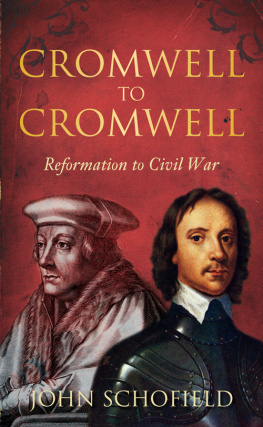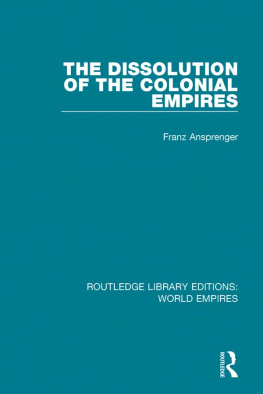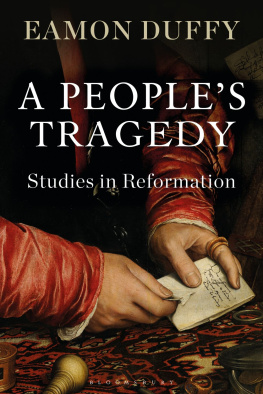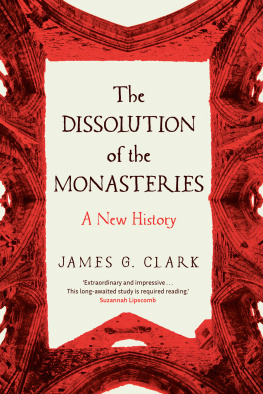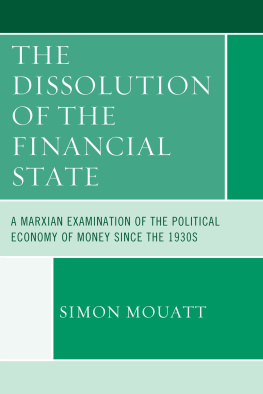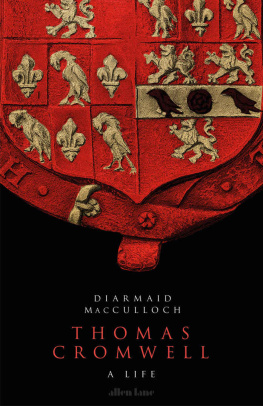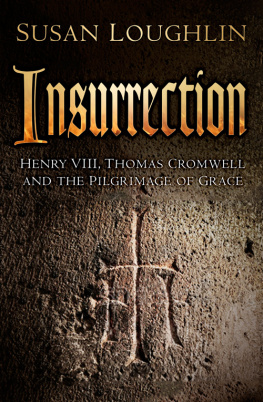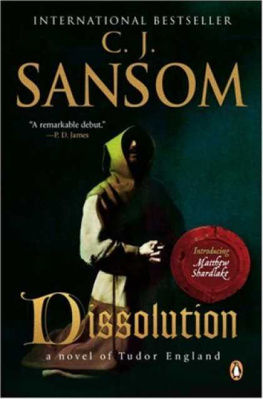HISTORICAL PROBLEMS
Volume 12
THE DISSOLUTION OF THE MONASTERIES
First published in 1971 by George Allen & Unwin Ltd
This edition first published in 2021
by Routledge
2 Park Square, Milton Park, Abingdon, Oxon OX14 4RN
and by Routledge
52 Vanderbilt Avenue, New York, NY 10017
Routledge is an imprint of the Taylor & Francis Group, an informa business
1971 George Allen & Unwin Ltd
All rights reserved. No part of this book may be reprinted or reproduced or utilised in any form or by any electronic, mechanical, or other means, now known or hereafter invented, including photocopying and recording, or in any information storage or retrieval system, without permission in writing from the publishers.
Trademark notice: Product or corporate names may be trademarks or registered trademarks, and are used only for identification and explanation without intent to infringe.
British Library Cataloguing in Publication Data
A catalogue record for this book is available from the British Library
ISBN: 978-1-03-203925-1 (Set)
ISBN: 978-1-00-319296-1 (Set) (ebk)
ISBN: 978-1-03-203845-2 (Volume 12) (hbk)
ISBN: 978-1-03-203850-6 (Volume 12) (pbk)
ISBN: 978-1-00-318936-7 (Volume 12) (ebk)
Publishers Note
The publisher has gone to great lengths to ensure the quality of this reprint but points out that some imperfections in the original copies may be apparent.
Disclaimer
The publisher has made every effort to trace copyright holders and would welcome correspondence from those they have been unable to trace.
THE DISSOLUTION OF THE MONASTERIES
Joyce Youings
University of Exeter

FIRST PUBLISHED IN 1971
This book is copyright under the Berne Convention.
All rights are reserved. Apart from any fair dealing for the purpose of private study, research, criticism or review, as permitted under the Copyright Act, 1956, no part of this publication may be reproduced, stored in a retrieval system, or transmitted, in any form or by any means, electronic, electrical, chemical, mechanical, optical, photocopying, recording or otherwise, without the prior permission of the copyright owner. Enquiries should be addressed to the publishers.
George Allen & Unwin Ltd, 1971
BRITISH ISBN 0 04 942089 5 cased
ISBN 0 04 942090 9 paper
USAISBN 389-04454-7
Printed in Great Britain in 10 point Plantin type by Cox and Wyman Fakenham
TO B.S
A fraction only of all the available material relating to the Dissolution of the Monasteries is available in print. Where suitable this has been used, although in some cases the author has introduced minor corrections where reference to the originals indicated that these were necessary. A good many of the documents printed here in extenso are already well-known from their being calendared in the Letters and Papers of Henry VIII. By and large the more formal documents, including the enrolled accounts, are in Latin, and these have been translated. In all cases spelling, punctuation, and the use of capital letters have been modernized. Place and personal names, as far as possible, have been given in their modern form. Explanations of archaic or technical words and phrases have been added in italic type, and, where necessary, sufficient words have been supplied to make the sense clear, all such editorial insertions being placed within square brackets. The notes preceding each document are largely factual and are intended to assist the reader to understand the text by placing it in its historical context. For a bibliography the reader is referred to the end of Dom David Knowless great classic, The Religious Orders in England III, but an appendix is included here of work on the Dissolution and allied topics published since 1959.
The author wishes to thank the following for permission to print documents: the Trustees of the British Museum; the Controller of Her Majestys Stationery Office, for Crown copyright material in the Public Record Office and for the map on p. 247; Professor V. H. Galbraith for Doc. I; the Town Clerk of Exeter for Doc. 12; Professor the Rev. M. D. Knowles and the editor of the English Historical Review for Doc. 24; and the editor of the Dugdale Society for Doc. 26b. Her debt to the many scholars who have worked in this field, especially in recent years, is, she hopes, sufficiently acknowledged in the appropriate places. For assistance with the final stages of the books preparation she is particularly grateful to Professor G. R. Elton, the editor of the series, who read and commented on an early draft, to Monica Channer who typed the manuscript so patiently and efficiently and to Peter Lock who helped substantially with the preparation of tiie index.
CONTENTS
INTRODUCTION
1 Problems and documents
2 The Crown and the smaller monasteries
3 The great and solemn monasteries
4 The Court of Augmentations takes charge
5 The dispersal of monastic lands
DOCUMENTS
1 A petition of some knights of Parliament, 1410
2 Bath Cathedral Priory lease, 1528
3 A petition from the parish of Wembury, Devon
4 Monastic resources
a. Valor of the revenues of Walsingham Priory, 1535
b. Pipewell Abbeys grant to Cromwell, 1531
5 A plan for root and branch disendowment of the Church
6 Departing canons of Bodmin: the priors letter, 1535
7 The visitors injunctions, 1535
8 Representations from the monks of St Augustines, Bristol
9 The uses of founders: Bridlington Priory, 1535
10 Parliamentary half-measures: the act of 1536
11 The commissioners instructions, 1536
12 Popular reactions at Exeter
13 Brief certificate for the county of Sussex
14 Thomas Starkey and the redisposition of monastic wealth
15 The Kings instructions regarding the monks of Whalley, 1537
16 The priors feed men
a. Newstead Priory
b. Ulverscroft Priory
17 Pressures and responses, 15389
a. The cellarer of Bordesley
b. The abbot of Combermere
c. The abbot of Pershore
18 Royal authority to dissolve, 1539
19 Eyewitnesses at Gloucester, 1538
a. The mayors memorandum
b. The bishops report
20 The commissioners in the West, 1539
a-d. Progress reports
e. The prior of Hintons letter to his brother
21 Deed of surrender of Forde Abbey, 1539
22 Dissolution accounts of St Osyths Abbey, Essex, 1539
23 Statutory confirmation of the Kings title, 1539
24 A moment in time: Evesham, 1540
25 The act establishing the Court of Augmentations, 1536
26 Ministers accounts
a. Cockersand Abbey estates, 15389
b. A Bath Priory manor, 15389
c. Warwickshire monastic lands, 15467
27 Receivers accounts
a. Herefordshire, 1536
b. Devon, 15589
28 Treasurers accounts


